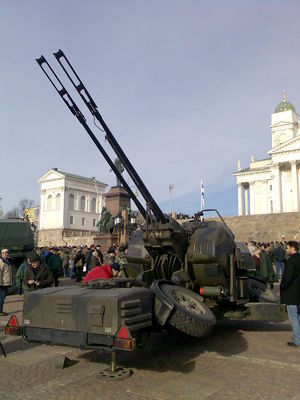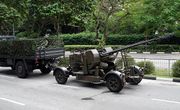Oerlikon 35 mm twin cannon
| 35 mm Oerlikon GDF-003 | |
|---|---|
 A modernized Finnish 35 mm Oerlikon twin cannon |
|
| Type | Autocannon |
| Place of origin | |
| Service history | |
| Used by | See operators |
| Specifications | |
| Weight | 6,700 kg (15,000 lb) (with ammunition) |
| Length | 7.8 m (25 ft 7 in) (travelling) |
| Barrel length | 3.15 m (10 ft 4 in) (barrel) |
|
|
|
| Shell | Complete round: - 35x228mmR, 1.565 kg (3.45 lb) |
| Caliber | 35 mm |
| Carriage | 4 wheels with outriggers |
| Elevation | -5°/+92° |
| Traverse | Full 360° |
| Rate of fire | 550 rounds/min (per barrel) |
| Muzzle velocity | 1,175 m/s (3,850 ft/s) (HEI-T) |
| Effective range | Ceiling: 4,000 m (13,123 ft 4 in) |
The Oerlikon 35 mm twin cannon is a towed anti-aircraft gun made by Oerlikon Contraves (renamed as Rheinmetall Air Defence AG following the merger with Rheinmetall in 2009). The system was originally designated as 2 ZLA/353 ML but this was later changed to GDF-001. It was developed in the late 1950s and is used by around 30 countries.
Contents |
Design & development
The system uses 35 mm autocannons, which were originally designated 353 MK and are now designated as the KD series. The same KD series 35 mm cannons are used in the Leopard tank based Gepard and Type 74 tank based Type 87 SPAAG and T-55 based Marksman self-propelled anti-aircraft guns. The system could be paired with the off-gun Super Fledermaus fire control radar, which in the late 1970s was upgraded to the Skyguard system.
In 1980 an upgraded model, the GDF-002 was produced, which featured an improved sight, and the ability to be directed by an off-gun digital control system. A few years later a third version of the system was being produced, the GDF-003, which was broadly similar to the GDF-002, but included some enhancements like self-lubricating weapons and integrated protective covers.
In 1985 a further upgraded model was produced, the GDF-005, which was introduced, featuring the Gunking 3D computer-controlled sight with an integrated laser range-finder and digital control system.
The guns are usually transported by a 5-tonne 6×6 truck.
Deployments
KD series cannons
Development of the KD series cannon began around 1952, Oerlikon calculated that 35 mm was the optimum calibre for an anti-aircraft gun. The KD series cannons were a design adapted from the post-war 20 mm KAA 204 Gk cannon. Several designs were developed, including a water cooled design, designated Mk 352, which was tested by the U.S. Navy. The final design was the Mk 323, which was developed in two variants, a belt fed version the KDA, and a linkless version the KDC, fed by five round clips. Both designs are gas operated with a propped lock locking system. [1]
Super Fledermaus

The Super Fledermaus fire control system was designed and built by the then separate Contraves company. It consists of a towed trailer with an E/F band pulse doppler search radar with a range of around 15 km and a pulse doppler tracking radar operating in the J band, also with a range of 15 km. It was also used as the fire control system on the Gepard SPAAG.
Skyguard
The Skyguard system is contained within a towed trailer, mounted on the roof of which is a pulse doppler search radar, a pulse doppler tracking radar and a co-axial television camera. The trailer also houses the crew of two and a small petrol generator.
A typical battery using the Skyguard consists of two twin 35 mm gun platforms with a single Skyguard fire control radar.
History
- 1982: The system was used by Argentine forces during the Falklands War. The Skyguard radar system was employed by the 601 Antiaircraft Artillery Group and the Super Fledermaus by the 1st Group of the Argentinian Air Force. The Skyguard succeeded in shooting down a Sea Harrier (XZ450) on 4 May 1982 at Goose Green. This resulted in a shift of tactics, so that British aircraft largely operated outside the weapons system's range. An RAF Harrier (XZ988) was shot down by the cannons again over Goose Green on 27 May.[2] The system was also employed in direct fire mode against British paratroopers during the Battle of Goose Green. The Skyguard radars were targeted by the RAF during Operation Black Buck on May 31 and June 3. One unit was destroyed as a result. Another Harrier (XW919) was presumably hit by 35 mm splinters over Sapper Hill on June 12 and sustained heavy damage.[3][4] The aircraft was later declared out of service. There was a further direct-fire mission conducted against British troops on Wireless Ridge, just hours before the Argentinian surrender.[5]. After being disabled by their operators the guns were captured by British forces. 15 guns and five Skyguard units were refurbished. 12 guns and 4 Skyguard radars were put into British service operated by the Royal Auxiliary Air Force 2729 Squadron, based at RAF Waddington.[6][7]
- 12 October 2007: In Lohatla, South Africa, nine defence force (SANDF) soldiers were killed and 14 injured by the system during a training exercise. A line of 8 cannons was engaging a tank hulk in manual ground fire with the guns at low elevation and the maximum traverse of the barrels secured by safety poles and tethers. The rightmost gun jammed while firing and had to be repaired by technicians. Shortly after the gun was cleared to fire again, the gun malfunctioned, entered automatic mode, broke through the traversal-restriction safety mechanisms and began firing, striking the other guns along the firing line. Initial reports suggested that the malfunction was caused when the gun underwent an unexplained gang fire of the explosive 35mm ammunition in the magazines, causing the turret to swing uncontrolled through 360-degrees firing wildly until it exhausted its remaining ammo. A statement issued by the South African Defense Minister Mosiuoa Lekota, however, stated that the gun had inexplicably traversed 90-degrees to the left, breaking through the safety mechanisms, and fired only a 1/8th second long burst, striking all of the soldiers located on the right hand side of their guns. [8][9]
- January 2008: The accident report by the SANDF blames "undetected mechanical failure—which the manufacturers of an anti-aircraft gun allegedly kept secret". The report says the gun malfunctioned because a spring pin, which is the size of a matchstick, sheared. Other sources blamed poor training and safety procedures in the SANDF.[10]
Ammunition
| NATO designation | HEI-T | HEI | HEI(BF) | SAPHEI-T | FAPDS | TP-T/TP | AHEAD |
|---|---|---|---|---|---|---|---|
| Projectile weight | 535 g (19 oz) | 550 g (19 oz) | 550 g (19 oz) | 550 g (19 oz) | 375 g (13 oz) | 550 g (19 oz) | 750 g (26 oz) |
| Explosive | 98 g (3 oz) | 112 g (4 oz) | 70 g (2 oz) | 22 g (1 oz) | n/a | n/a | n/a |
| Propellant | 330 g (12 oz) | ||||||
| Complete round | 1,565 g (55 oz) | 1,580 g (56 oz) | 1,580 g (56 oz) | 1,552 g (55 oz) | 1,440 g (51 oz) | 1,580 g (56 oz) | 1,780 g (63 oz) |
| Muzzle velocity | 1175 m/s | 1175 m/s | 1175 m/s | 1175 m/s | 1440 m/s | 1175 m/s | 1050 m/s |
- Designation:
- HEI: High Explosive Incendiary (-T—Tracer)
- SAPHEI: Semi-Armour Piercing High Explosive Incendiary
- FAPDS: Frangible Armour Piercing Discarding Sabot
- AHEAD: Anti-missile rounds, that fire "152 heavy tungsten metal sub-projectiles".
- TP: Target Practice (-T—Tracer)
Versions


- GDF-001 / '2 ZLA/353 MK: XABA sight
- GDF-002: Introduced in 1980. Improved Ferranti sight and digital data bus. The gun has 112 rounds ready and 126 in reserve (238 rounds total)
- GDF-003: Minor enhancements including protective covers and automatic weapon lubrication.
- GDF-005: Introduced in 1985. Fitted with Gunking 3D computer controlled sight with a laser range finder and digital fire control system. Integrated power supply and diagnostics. 280 rounds on the gun and an automatic re-loading system.
- GDF-006: GDF-001/002/003 upgraded with AHEAD system.
- GDF-007: GDF-005 upgraded with AHEAD system.
- AHEAD: An upgrade for the GDF series guns built around a special projectile which explodes at a pre-calculated point in front of the target sending a spinning cone of 152 tungsten sub-projectiles at the target. Used by Canada, Greece, Oman, Spain and Chile (unconfirmed).
- Gepard: Self propelled version of the system based around the Leopard tank.
- Marksman: Self propelled version of the system based around the Marksman turret, which could be fitted on numerous tank chassies. The only model that went into production was a version based on the T-55 chassis for Finland, 10 systems in use.
- Type 87: Japanese SPAAG using the system.
- PZA Loara: Polish SPAAG based on the PT-91 tank
- Type 90: Chinese licensed copy of GDF-002
- samavat: Iranian version of these guns with night vision sight and Used with Skyguard & Super Fledermaus FC radars.
Operators

 Argentina: 50+ GDF-002 units, XABA sight used
Argentina: 50+ GDF-002 units, XABA sight used Austria: 74 GDF-005 Army, Air Force 18 GDF-005
Austria: 74 GDF-005 Army, Air Force 18 GDF-005 Bahrain: 12 GDF-005 units
Bahrain: 12 GDF-005 units Brazil: 38 GDF-001 with updated Super Fledermaus and Brazilian made Skyguard FC radars
Brazil: 38 GDF-001 with updated Super Fledermaus and Brazilian made Skyguard FC radars Cambodia
Cambodia Canada: 20 GDF-005 units and 10 Skyguard FC radars, to be phased out. AHEAD modified.
Canada: 20 GDF-005 units and 10 Skyguard FC radars, to be phased out. AHEAD modified. Chile: 24 GDF-005 units, Plus 30 surplus ex-Flugabwehrkanonenpanzer Gepard vehicles purchased from Bundeswehr stocks
Chile: 24 GDF-005 units, Plus 30 surplus ex-Flugabwehrkanonenpanzer Gepard vehicles purchased from Bundeswehr stocks China: licensed copy of GDF-002 as the Type 90, 150+ units with Skyguard FC radar[11]
China: licensed copy of GDF-002 as the Type 90, 150+ units with Skyguard FC radar[11] Cyprus: 30 GDF-005 units used with Skyguard and Aspide SAM
Cyprus: 30 GDF-005 units used with Skyguard and Aspide SAM Ecuador: 30 GDF-003 units
Ecuador: 30 GDF-003 units Egypt: 72 GDF-003 units used with Skyguard and Sparrow SAM
Egypt: 72 GDF-003 units used with Skyguard and Sparrow SAM Finland: 16 units. Known as 35 ITK 88
Finland: 16 units. Known as 35 ITK 88 Germany: On the Flugabwehrkanonenpanzer Gepard (self-propelled anti-aircraft gun)
Germany: On the Flugabwehrkanonenpanzer Gepard (self-propelled anti-aircraft gun) Greece: 44 GDF-002 units used with Skyguard and Aspide SAM
Greece: 44 GDF-002 units used with Skyguard and Aspide SAM Iran: 92 GDF-002 units. Iran claims it is producing/refurbishing these guns. Used with Skyguard & Super Fledermaus FC radars.
Iran: 92 GDF-002 units. Iran claims it is producing/refurbishing these guns. Used with Skyguard & Super Fledermaus FC radars. Indonesia
Indonesia Japan: some 70 GDF-001 units, used with updated Super Fledermaus FC radars. Made under a joint venture with Japan Steel Works for the 35mm gun and Mitsubishi Electric Corporation for the rest of the system[12]
Japan: some 70 GDF-001 units, used with updated Super Fledermaus FC radars. Made under a joint venture with Japan Steel Works for the 35mm gun and Mitsubishi Electric Corporation for the rest of the system[12] South Korea: 18+ GDF-003 units
South Korea: 18+ GDF-003 units Kuwait: 12 GDF-005 units, used with Skyguard and Sparrow SAM
Kuwait: 12 GDF-005 units, used with Skyguard and Sparrow SAM Malaysia: 28 GDF-003 units
Malaysia: 28 GDF-003 units Oman: 10 GDF-005 units AHEAD modified
Oman: 10 GDF-005 units AHEAD modified Pakistan: estimated 200 GDF-002 units
Pakistan: estimated 200 GDF-002 units Romania: 43 Flugabwehrkanonenpanzer Gepard systems and 72 GDF-003 units
Romania: 43 Flugabwehrkanonenpanzer Gepard systems and 72 GDF-003 units Saudi Arabia: 128 GDF-005 modified units. Used with Skyguard FC radars.
Saudi Arabia: 128 GDF-005 modified units. Used with Skyguard FC radars. Singapore: 34 GDF-002 units
Singapore: 34 GDF-002 units South Africa: some 100 GDF-002 + 48 modified GDF-005 units
South Africa: some 100 GDF-002 + 48 modified GDF-005 units Spain: 92 GDF-005 units, being upgraded to 007 standard. Skydor and Skyguard FC radars.[13]
Spain: 92 GDF-005 units, being upgraded to 007 standard. Skydor and Skyguard FC radars.[13] Switzerland: 45 GDF-007 modified units (from Total of 264 GDF-001/002 units)
Switzerland: 45 GDF-007 modified units (from Total of 264 GDF-001/002 units) Taiwan: 24 Skyguard Fire Control radars linked to GDF-003 35 mm twin guns
Taiwan: 24 Skyguard Fire Control radars linked to GDF-003 35 mm twin guns Turkey: some 120 GDF-002 units
Turkey: some 120 GDF-002 units United Arab Emirates: 30 GDF-005 units
United Arab Emirates: 30 GDF-005 units United Kingdom: Total of 15 GDF-002 35mm twin guns were captured during the Falklands War along with 6 Skyguard and one Super Fledermaus FC Radars. One of the Skyguard radars was damaged from a Shrike missile strike during the conflict. Currently four Skyguard fire control systems for these guns are being used to catch UK military aircraft exceeding flight restrictions over residential areas. GDF-002 guns now in storage. [14]
United Kingdom: Total of 15 GDF-002 35mm twin guns were captured during the Falklands War along with 6 Skyguard and one Super Fledermaus FC Radars. One of the Skyguard radars was damaged from a Shrike missile strike during the conflict. Currently four Skyguard fire control systems for these guns are being used to catch UK military aircraft exceeding flight restrictions over residential areas. GDF-002 guns now in storage. [14]
See also
- List of artillery
- List of anti-aircraft artillery
- List of artillery of Germany
- List of artillery of Switzerland
- Oerlikon Millennium 35 mm Naval Revolver Gun System related development
References
- Notes
- ↑ George M. Chinn, The Machine Gun, Volume V
- ↑ Pook, page 109
- ↑ ”During the attack, Macleod's aircraft was hit by shrapnel which penetrated the rear equipment bay area of the aircraft and fractured the aft reaction control air pipe. On decelerating to the hover during the recovery, this caused a fire to start in the rear equipment bay and smoke as seen coming from the aircraft. Fuel indications suggested a considerable fuel leak at the same time. MacLeod executed a very quick and professional landing in worrying circumstances. Having landed-on, the fire was extinguished by the groundcrew.” RAF diaries , 12 June entry
- ↑ (Spanish) En uno de esos ataques -12 de Junio- el enemigo en vuelo rasante (150 mts. del suelo) descargó todos sus cohetes sobre el cañón: resultaron seis heridos leves y fue “tocado” por la propia artillería antiaérea; uno de los sirvientes descargó sobre la máquina enemiga su fusil FAL; el cañón continuó en servicio. Rodríguez Mottino, page 91
- ↑ Pook, page 162
- ↑ Hansard January 1985
- ↑ Britains Small Wars - Argentine Weapons
- ↑ Robot Cannon Kills 9, Wounds 14 | Danger Room from Wired.com
- ↑ Military accident: 'stop speculation'. South Africa Independent online, retrieved on 17 October 2007
- ↑ Pretoria News, p.3 on 2008 January 26
- ↑ Type 90 Twin-35mm Towed Anti-Aircraft Artillery. Retrieved on August 1, 2008.
- ↑ (Japanese) 35mm2連装高射機関砲 L-90. Retrieved on August 1, 2008.
- ↑ (Spanish) Spanish Minister of Defense official website. May 2008.
- ↑ House of Commons Hansard for 11 Feb 2002 (pt 5).
- Bibliography
- Jane's Land-Based Air Defence 2005–2006, by James C O'Halloran, ISBN 0-7106-2697-5
- RAF Harrier Ground Attack-Falklands, by Jerry Pook, ISBN 9781844155514
- The Machine Gun, Volume V, George M. Chinn
- Rheinmetall page on 35 mm ammo
- La Artillería Argentina en Malvinas, by Horacio Rodríguez Mottino. (Spanish)
- (Russian) Skyguard-Sparrow
- Iran mass produces 35mm anti-aircraft gun, Press TV. January 15, 2008.
- Online